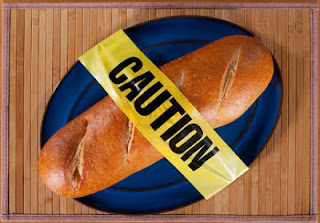 |
| Dr Murray Mayo Clinic |
Over at Awakening Potentials Dr. Tony and Dr. Marcelle have a gentle reminder to avoid the usual or the most common mistakes people make when they are gluten sensitive or celiac.
This article is so important as we have research that shows that just one or more meals or snacks containing gluten a month increases ones death rate by 6% A YEAR! I see it in my practice and I still have a hard time understanding how the modern wheat is so toxic.
And gluten sensitivity is twice as common and has four times the morbidity and mortality. And see more published research by Ludvigsson and Anderson, here and here.
Gluten Sensitivity is not a fad, it is a fact.
Here is an excerpt: Gluten Sensitivity is finally gaining traction. People are becoming aware of the symptoms of Gluten intolerance, and even some medical doctors are aware of this. So what are the symptoms you ask?
Migraines and Tension Headaches
This article is so important as we have research that shows that just one or more meals or snacks containing gluten a month increases ones death rate by 6% A YEAR! I see it in my practice and I still have a hard time understanding how the modern wheat is so toxic.
And gluten sensitivity is twice as common and has four times the morbidity and mortality. And see more published research by Ludvigsson and Anderson, here and here.
Gluten Sensitivity is not a fad, it is a fact.
Here is an excerpt: Gluten Sensitivity is finally gaining traction. People are becoming aware of the symptoms of Gluten intolerance, and even some medical doctors are aware of this. So what are the symptoms you ask?
Migraines and Tension Headaches
Sore Joints, aka arthritis
Brain Fog
Skin Rashes
Depression
and of course, Digestive Problems
You can have any or all of the above symptoms, but you need to understand, this is not always a digestive problem.
Here are the common mistakes people make when going gluten free:
Want to gain 20 healthy years to your life then go 100% gluten and grain free, like GAPS diet and protocol to remedy the complications that have occurred, remedy the MTHFR polymorphisms that encourage B vitamin, zinc and magnesium deficiencies. And restore the proper microbiota that are so life giving to us. Read the book Gut and Psychology Syndrome to become educated on how rice, corn and other grains cause leaky gut and destroy the healthy bacteria.
Brain Fog
Skin Rashes
Depression
and of course, Digestive Problems
You can have any or all of the above symptoms, but you need to understand, this is not always a digestive problem.
Here are the common mistakes people make when going gluten free:
- Thinking they can cheat “a little bit”. You can’t cheat at all!
- Not reading labels. Wheat and gluten are added to almost everything!
- Bringing large amounts of “gluten free” products into their diet, too much sugar!
- Substituting corn, or rice in large amounts for the missing wheat. Leads to more problems!
Want to gain 20 healthy years to your life then go 100% gluten and grain free, like GAPS diet and protocol to remedy the complications that have occurred, remedy the MTHFR polymorphisms that encourage B vitamin, zinc and magnesium deficiencies. And restore the proper microbiota that are so life giving to us. Read the book Gut and Psychology Syndrome to become educated on how rice, corn and other grains cause leaky gut and destroy the healthy bacteria.
To Your Health
Dr. Barbara















